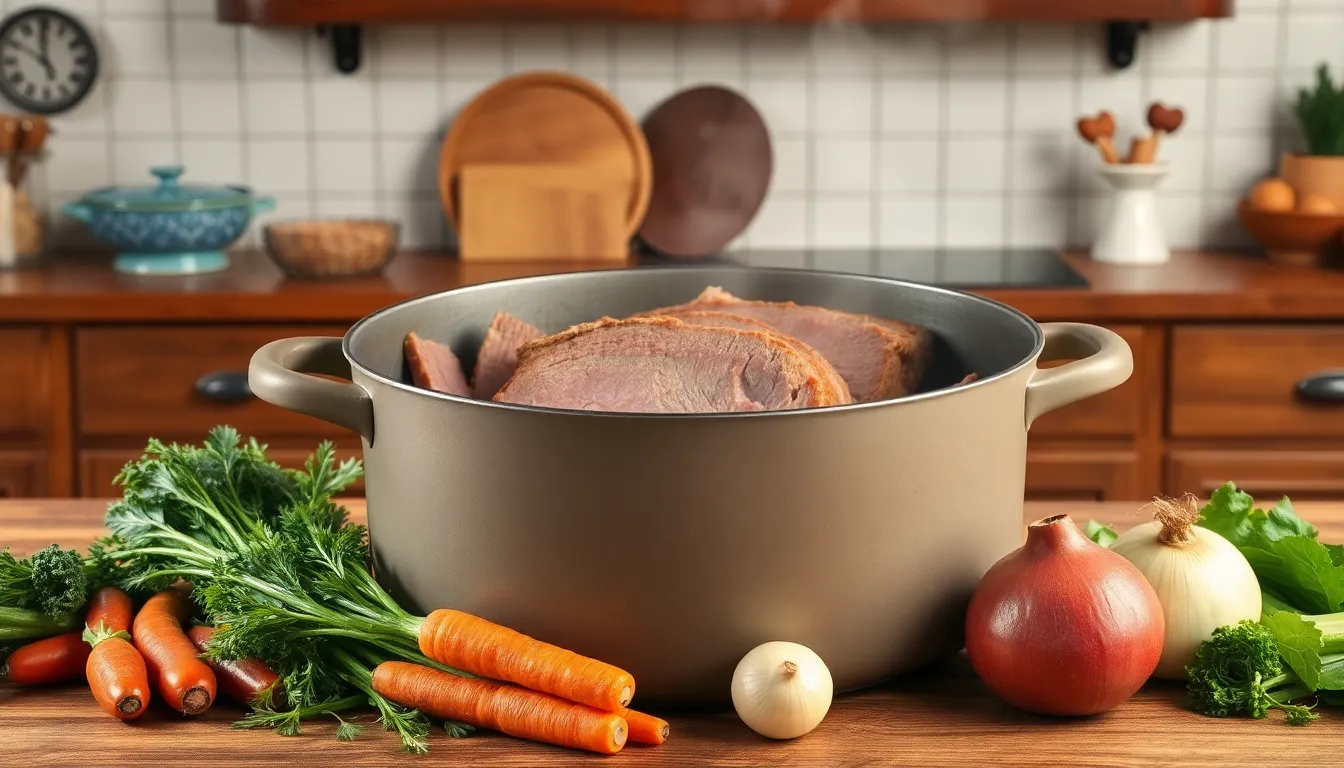When it comes to corned beef, timing is everything. Boiling it to perfection transforms a tough cut of meat into a tender, flavorful feast that’ll have everyone asking for seconds. But how long does it take to achieve that melt-in-your-mouth goodness? Spoiler alert: it’s not as simple as just turning on the stove and hoping for the best.
Table of Contents
ToggleUnderstanding Corned Beef
Corned beef offers unique flavors and textures. Cooking this particular cut properly makes a significant difference in the outcome of the dish.
What Is Corned Beef?
Corned beef is a type of brisket, usually made from the beef round or plate. This meat undergoes a curing process that involves brining in seasoned saltwater. The term “corned” comes from the coarse salt, known as “corns,” used in the curing process. As a result, corned beef develops a distinct taste, often enhanced with spices like peppercorns, bay leaves, and mustard seeds during preparation.
Types of Corned Beef
Several types of corned beef exist, each offering slight variations in flavor and texture. Flat cut corned beef boasts a leaner profile, while point cut contains more fat, providing added juiciness and flavor. Additionally, some variations include marinated or spiced options, offering unique twists to traditional corned beef. Pre-packaged corned beef often comes with seasoning packets, making it convenient for home cooks.
Preparing to Boil Corned Beef

Preparing to boil corned beef involves gathering essential ingredients and necessary equipment. Ensuring everything is in place helps streamline the cooking process.
Essential Ingredients
Corned beef consists of a few key ingredients. The primary element is the brisket, typically found in either flat cut or point cut varieties. Curing salt plays an important role, enhancing flavor and tenderizing the meat. Many cooks opt for a seasoning packet, which usually includes spices like coriander, mustard seed, and black pepper. Additionally, vegetables such as carrots, celery, and onions contribute to the dish’s flavor. It’s common to add garlic cloves or bay leaves for extra aroma. Water serves as a cooking medium, ensuring even heat distribution and moisture during boiling.
Equipment Needed
A few tools simplify the boiling process. A large pot is essential for accommodating the size of the brisket and the water. A lid helps retain heat and moisture effectively. A meat thermometer ensures the internal temperature reaches a safe level, typically around 200°F for tender results. Tongs allow easy handling of the meat during preparation. A cutting board becomes necessary for slicing the cooked corned beef. Finally, serving utensils complement the dish, making it easy to enjoy once cooked.
How Long to Boil Corned Beef
Boiling corned beef requires attention to cooking times for optimal tenderness and flavor. The following guidelines help ensure the best results.
General Cooking Time Guidelines
Cooking corned beef generally takes about 2.5 to 3 hours per pound. For a 3-pound brisket, this translates to roughly 7.5 to 9 hours of boiling time. Boiling at a gentle simmer promotes even cooking while keeping the meat tender. It’s beneficial to check the internal temperature regularly, targeting 190°F for optimal texture. Once the meat reaches this temperature, it should shred easily.
Factors Affecting Cooking Time
Several factors can influence the cooking time of corned beef. The cut of meat, whether flat cut or point cut, affects how long it needs to cook. Thicker cuts generally require more time to become tender. Additionally, cooking in high altitudes may increase boiling times due to different atmospheric pressure. The size of the cut, the specific stove’s heat output, and even the pot used can alter boiling times. For best results, monitor the meat’s doneness throughout the boiling process.
Tips for Perfectly Boiled Corned Beef
Achieving perfectly boiled corned beef involves attention to detail in both seasoning and monitoring doneness. These steps enhance the overall flavor and tenderness of the meat.
Seasoning and Flavoring
Using the right spices elevates corned beef’s flavor. Curing salt serves as the base, contributing to both flavor and preservation. Common spices found in seasoning packets include coriander, mustard seed, and black peppercorns. Adding garlic cloves and bay leaves introduces additional depth to the taste. Incorporating vegetables like carrots, celery, and onions not only enhances flavor but also adds nutrients to the boiling broth. Always adjust seasonings to personal preferences, creating a customized taste profile. A well-seasoned boiling liquid results in richer, more flavorful corned beef.
Checking for Doneness
Checking for doneness ensures optimal texture and safety. After boiling for the recommended time, using a meat thermometer provides accurate readings. Aim for an internal temperature of 190°F to guarantee tenderness. Visual cues also help; the meat should easily pull apart and exhibit a pinkish hue. If the meat isn’t tender after the suggested boiling time, continue cooking and monitor frequently. Factors such as the size of the cut and individual stove variations affect cooking times, making regular checks crucial. Properly cooked corned beef enhances the overall dining experience.
Boiling corned beef is an art that requires attention to detail and patience. By following the recommended cooking times and ensuring the right seasonings are used, anyone can transform a tough cut of meat into a succulent dish. The careful monitoring of temperature and doneness plays a vital role in achieving that perfect tenderness.
Ultimately, the effort put into boiling corned beef pays off with a flavorful and satisfying meal. Whether served with traditional sides or incorporated into creative recipes, well-cooked corned beef is sure to impress at any gathering.









